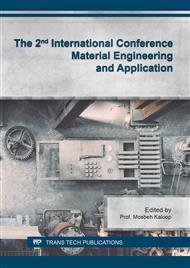[1]
V. V. Bolotin, Methods of probability and reliability theories applied in analysis of structure, Moscow: Stroyizdat, (1982) 350 pp. (in Russian).
Google Scholar
[2]
V. V. Bolotin, Resource prediction for machines and structures, Moscow: Mashinostroenie, (1982) 312 pp. (in Russian).
Google Scholar
[3]
A. P. Bulychev, Probabilistic economic method of determining equivalent loads on bearing structural components, J. Struct. Mech. Anal. Struct. 1 (1982) 6-9. (in Russian).
Google Scholar
[4]
A. J. Driving, On defining numerical characteristics of structural reliability with economic liability taken into account, Papers of the II all-Russia conference on reliability problems in structural mechanics, Vilnius, (1968).
Google Scholar
[5]
A. J. Driving, Recommendations on implementation of economic statistical methods while carrying out analysis of structure with economic liability taken into account, Moscow, 61 (1972) (in Russian).
Google Scholar
[6]
J. M. Eisenberg, L. Sh. Kilimnik, On applying criteria of limiting states and diagrams restoring force - displacement, to seismic loads calculation, Seismic resistance of buildings and engineering facilities, Moscow: Stroyizdat, (1972).
Google Scholar
[7]
J. M. Eisenberg, A. I. Neumann, Economic assessment of optimality for quake proof structures and the principle of balanced risk, J. Struct. Mech. Anal. Struct. 4 (1973) 24-32. (in Russian).
Google Scholar
[8]
S. V. Medvedev, Considering economic efficiency for antiseismic reinforcement of building structures. Issues of engineering seismology, J. Proceedings of the Academy of Sciences of the USSR, 7 (1962) (in Russian).
Google Scholar
[9]
A. P. Pshenichkin, B. A. Garagash, Probabilistic analysis of mass production building structures on inhomogeneously deformed footings, Reliability and durability of building structures, Volgograd, (1974) 182 pp. (in Russian).
Google Scholar
[10]
V. D. Reiser, Structural reliability calculation and normalization, Moscow: Stroyizdat, (1995) 352 pp.
Google Scholar
[11]
V. D. Reiser, Reliability theory in structural design: Monograph, Moscow, (1998) 304 pp. (in Russian).
Google Scholar
[12]
A. R. Rzhanitsin, Design theory for building structures, Moscow: Stroyizdat, (1978) 240 pp (in Russian).
Google Scholar
[13]
N. N. Skladnev, Optimum structural design and efficient use of material resources, J. Struct. Mech. Anal. Struct. 6 (1982) 17-22. (in Russian).
Google Scholar
[14]
T. V. Zolina, Aggregated algorithm for acting loads design with assessment of residual life-cycle, J. Ind. Civil Eng. 6 (2014) 3-5. (in Russian).
Google Scholar
[15]
T. V. Zolina, P. N. Sadchikov, Predicted effects of design solutions aimed at reliability of industrial building structures, J. Herald of Moscow State University of Civil Engineering, 11 (2015) 68-79. (in Russian).
Google Scholar
[16]
T. V. Zolina, P. N. Sadchikov, Revisiting the Reliability Assessment of frame constructions of Industrial Building, Appl. Mech. Mater. 752-753 (2015) 1218-1223. (in English).
DOI: 10.4028/www.scientific.net/amm.752-753.1218
Google Scholar
[17]
T. V. Zolina, P. N. Sadchikov, Vector field modeling of seismic soil movement in building footing, Advanced Materials, Structures and Mechanical Engineering Proceedings of the international Conference on Advanced Materials, Structures and Mechanical Engineering, Incheon, South Korea, (2016).
DOI: 10.1201/b19693-26
Google Scholar
[18]
T. V. Zolina, P. N. Sadchikov, Evaluation of software realization algorithms of industrial building operation life, Advances in Energy, Environment and Materials Science Proceedings of the International Conference on Energy, Environment and Materials Science (EEMS 2015), Guanghzou, P.R. China, (2016).
DOI: 10.1201/b19635-154
Google Scholar


